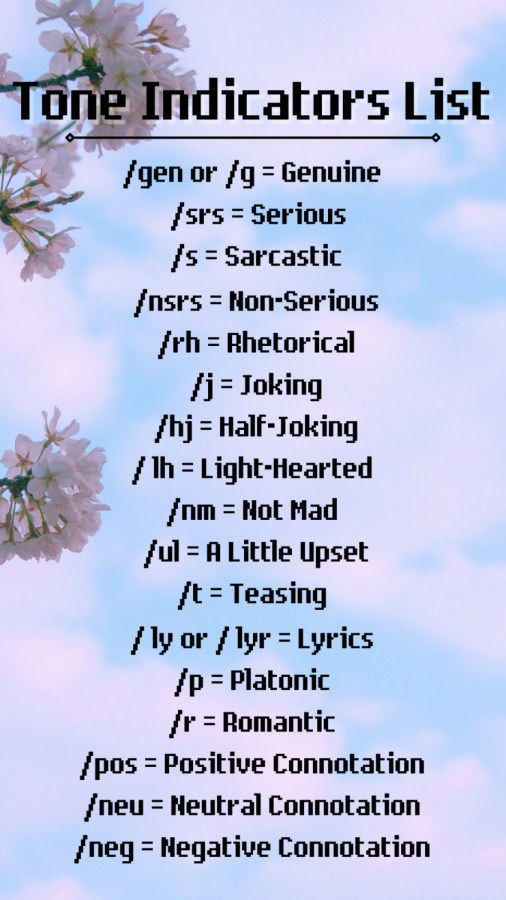Tone indicators
What they are, how to use them
Tone indicators are becoming increasingly more popular and used within texts and online spaces. Initially, they were created to help neurodivergent people understand the way in which others meant words, phrases, paragraphs, and etc. However, as time went on, people realized the usefulness that tone indicators can have for all people.
Tone indicators, also called tone tags, are used at the end of messages to explain the tone in which they should be read. They are typically used for ambiguous statements so others can understand; however, since not everybody has the same level of comprehension or understanding for things you might see as a “common phrase”, it is becoming
more and more common to use it for messages in general. For example, if I was sent a text saying “Be home soon.” by one of my parents, that would make me worry that I may have been in trouble or something bad was going on within my family. If the text was re-written to say something similar to “Be home soon. /lh [Lighthearted]”, I would more easily realize that it was more likely a friendly reminder than an angry text message.
The symbols can be used with any message you send to others, so long as it’s not used in an attempt to diminish the meaning of tone tags (such as tagging a message as “/srs [serious]” when it’s really just a joke) as that can cause confusion for those reading what was sent. There can also be multiple tone indicators used at once to help convey a message, such as pairing together a rhetorical question that was sent to poke fun at somebody. The indicators would appear at the end of the text stacked by each other, such as, “Did you really not taste the difference between grape and blueberry flavored candy? /rh /t [rhetorical and teasing]”. Additionally, tone indicators can also be used throughout a message sent if the tone is changed, for example, “I can’t believe I got a 98 on the quiz! /gen [genuine] That’s got to be the worst score I’ve ever gotten /s [sarcastic]”.
While the format of tone indicators may be new, the concept of them have been around since medieval times. Some of the earliest known examples of this would be the “Percontation Point” which was created by Henry Denham, an English printer. He proposed that it would look like a backwards question mark and would be used to indicate a rhetorical question in things such as texts and letters to explain that no answer was needed to the question. Then, in 1668, John Wilkons suggested using an inverted exclamation mark to show irony in texts. Throughout history, other marks were used to try and explain the tone or emotion in which a piece of text should be read besides using words alone. Now, the modern day equivalent of this has left us with tone indicators which can explain, in more depth, the way in which a piece of text should be read.

Claire Nappier is currently a senior at WHS. They have been on staff for three years and have developed a love for journalism during their time on staff....










![Jaywalkers junior dancers Isabella Fitzgerald and Gabrielle Ziglin pose before the start of their performance in the Big Blue Jay Gym on Wednesday, Jan. 5. "[Nationals] is such a big competition, but obviously we want to go, we want to do good and we want to maybe take something home," Ziglin said. The dance team will compete at national competition Feb. 18-20 and and their state competion on Sat. Feb. 26 at the Family Arena in St. Charles.](https://WHSadvocateonline.com/wp-content/uploads/2022/01/Copy-of-IMG_0055-475x317.jpg)
